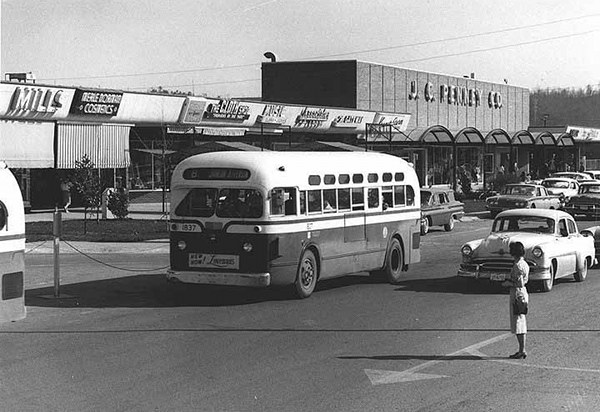
A crowd outside Walgreen Drugs at the former Downtown Shopping Center on December 2, 1955. (Photos courtesy Don Hunnicutt/Ed Westcott)
Note: This story was last updated at 8:20 a.m. Dec. 31.
After we learned that Guilford Glazer died last week, we asked Don Hunnicutt if he or Ed Westcott, the government’s official photographer in Oak Ridge during World War II, had any pictures of the former Downtown Shopping Center that we might use on Oak Ridge Today. Don sent five pictures Tuesday morning. (Thank you, Don and Ed!)
Glazer, who was born in Knoxville, died last week in Beverly Hills, California, at 93. His company built the former Downtown Shopping Center in Oak Ridge in the 1950s, and he still owns property in Oak Ridge and Knoxville.
After World War II, Glazer took over the family welding shop and turned it into a major steel fabrication business, Glazer Steel Corporation. His first development was a building in Knoxville that has been described as the city’s first high-rise apartment building. In 1951, the U.S. Atomic Energy Commission picked Glazer’s company to build the former Downtown Shopping Center in Oak Ridge. It opened in 1955.
Still remembered fondly, the Downtown Shopping Center later became the Oak Ridge Mall. It is now officially known as Oak Ridge City Center. There is a plan to redevelop the 59-acre site as a mixed-use project called Main Street Oak Ridge.
Ray Evans, Oak Ridge’s retail consultant, said J.C. Penney himself cut the ribbon for the J.C. Penney store at the Downtown Shopping Center. It was one of the original stores at the shopping center, Evans said.
Evans said there are still roof trusses coated with red primer stenciled with white Glazer Steel lettering above the old Sears store (the old A&P store).
Several people in the business community said Glazer has also donated property between Rutgers Avenue and Oak Ridge Turnpike.
Donna Sullivan, owner of Hot Bagel, became friends with Glazer through her father, Don Maxwell, who was president and chief executive officer of Bank of Oak Ridge. Sullivan stayed in touch with Glazer, who became her role model after her father died.
“He wanted this business (Hot Bagel) to succeed just because of us putting our heart and soul into it,” Sullivan said. “He liked all businesses, especially small businesses, to succeed.”

The new Downtown Shopping Center in Oak Ridge is pictured above in 1955. J.C. Penney is at center left. In the background are the three-story Manhattan Apartments. The area at upper right is roughly the area where South Illinois and Rutgers avenues now intersect. The Y-12 National Security Complex is over the ridge at right, and the area between the ridges is Scarboro Road.
After developing and acquiring numerous buildings in the Southeast and a few northern cities, Glazer moved his main office and residence to Beverly Hills, California, in 1960, according to Pepperdine University. From there, he continued developments as far east as Boston and Philadelphia and north to Chicago and Cincinnati.
“He was always very busy, very active,” said Tom Hill, former owner and publisher of The Oak Ridger newspaper.
Hill said Glazer was always easy to talk to and very friendly.
“He was driven,” Hill said. “He was determined to succeed.”
But, he added, “He went about it in a very nice way.”
In a story last week, the Beverly Hills Courier said Glazer, who also became a leading philanthropist, first made his mark in Los Angeles in the 1970s, when he developed the Del Amo Fashion Center in Torrance, which was the largest mall in the country until the Mall of America opened.
His company was later involved in shopping center development throughout the country, amassing a fortune that led to him appear regularly on Forbes’ “List of 400 Richest Americans.”



Carole Schulman says
What a pleasure. I wish there could be a book with pictures like these of the shopping center as it was and as it evolved. I would sure buy it. Thanks for asking Mr. Westcott and tanks to him for providing these.
Ray Evans says
Does anyone remember the carnival that used to locate in the corner next to Walgreen’s before the Loveman’s building was constructed?
Philip W Nipper says
Yes Ray. I sure do remember the carnival rides. As a wee lad in the early 60’s my dad would sometimes take us there after church. I remember it being in the corner lot between Walgreen’s and the original location of Western Auto. Real close to Federal Bakery. Where Profitt’s dept store was located? I think Loveman’s was at the other corner which later was Miller’s.
Ray Evans says
Philip
You are correct about Loveman’s being at the other end. Loveman’s moved from Jackson Square to the Downtown Center. Loveman’s became Millers in 1967 then Millers became Belk in 1987. The Proffit’s store in the “carnival corner” was constructed in 1974.